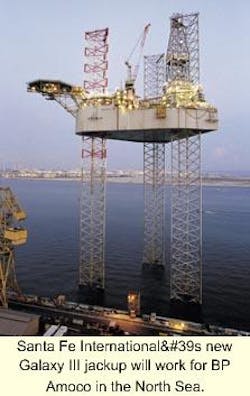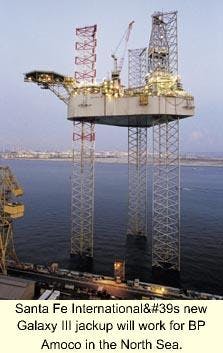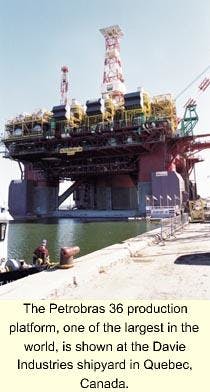IADC cautiously optimistic over contracts, prices
Although oil was at $24/bbl during the time of the annual International Association of Drilling Contractors (IADC) meeting in Houston last month, no one at the meeting seemed to be very excited about it. "This is the price you pay for being one step removed from the oil prices," one attendee said. "We have to wait for the operators to get confidence in the price before we can even begin to get excited."
Many members seemed confident that conditions will get better, but perhaps not until next year. Oil and gas producers are beginning to loosen drilling budgets, and more rigs are going back to work, which should begin lending real support for higher day rates. However, this will not happen fast enough for drillers. There were other areas of concern for drillers:
- Drilling fleet consolidation: The drillers are the most heavily fragmented sector of the industry and several of the large players are calling for consolidation similar to that taking place elsewhere in the industry. However, Leonard Paton of Chase Securities said the drilling sector was very different from the rest of the industry. He noted that the economic advantages of combining two drilling companies is relatively small.
The main holdback of the sector are social issues, he pointed out. This involves the egos of the heads of large drilling companies and their competitive nature. Rumors persist that at least two major mergers in the past 12 months have been called off because of this issue.
- Floating day rates: Another issue was the need to work closer with operators over the adjustment of day rates. One proposal was to float day rates - meaning the day rate would be tied directly to oil and gas prices. Whether that idea is feasible or not, a need was expressed to develop a way to insure both the driller, the operator, and the service companies from being damaged by shifts in oil prices.
In addition to discussion about these concerns, Reed-Hycalog and Simmons & Company International presented some findings with respect to the fleet. Notable findings from the 47th Annual Reed-Hycalog Rig Census are:
- Available rigs have fallen to 1,644 - onshore and offshore.
- Rig activity is down to 860 active rigs.
- Rig utilization has dropped to 52.3%
- Contractor rig rates are lower.
- The top contractor concerns are: rig rates, crew availability, and aging rig equipment
- The predicted utilization for 2000 was 73%.
Notable findings from the Simmons & Company International 1999 Annual Driller Survey Results (for the offshore sector) are:
- Rig utilization is down 17% - to 77%.
- The use of turnkey increased from 1% to 2%
- The average rig waiting period fell from 7.9 months last year to 3.1 months.
- Capital expenditure per marketed rig increased 49% to $1.33 million.
New Galaxy rig in operation
Santa Fe has taken possession of the newest jackup in the fleet. Keppel FELS has delivered the newbuild Galaxy III jackup to Santa Fe International and the rig is set to begin its initial three-year contract for BP Amoco in the North Sea at a rate of $160,000 per day.
The Galaxy III is a heavy duty harsh environment jackup of the Friede & Goldman L-780 MOD VI design. The rig is equipped to drill to 30,000 ft in 400 ft water depth. In addition, the drilling package can be skidded from the cantilever onto an adjacent platform to operate in tender assist mode and access a wider range of drilling positions. The rig also features a jacking system developed by Keppel FELS research and development subsidiary Offshore Technology Development.
The Galaxy III is the third jackup based on the Friede & Goldman L-780 MOD VI design, and follows the Galaxy I and Galaxy II, also owned by Santa Fe and built by Keppel FELS. The Galaxy III cost $179 million and was delivered on time.
Davie christens giant Roncador floater
Despite Davie Industries' recent troubles with potential bankruptcy, the Canadian shipyard has delivered the world's largest floating production semisubmersible platform to Maritima Petroleo of Brazil. The vessel, formerly known as the Spirit of Columbus, has been renamed the Petrobras 36, and is on its way to the Roncador Field in the Campos Basin offshore Brazil.
Upon arrival in the next few months, the Petrobras 36 will be the largest platform in the Brazilian fleet and will be capable of producing in over 1,350 meters water depth, making it one of the deepest operating production platforms. With a production capacity of 180,000 b/d of oil and 7.2 MMcf/d of gas, the platform alone has the capability of supplying almost 18% of Brazil's domestic oil production.
The construction of the platform took 24 months and entailed a total refit. Davie had to strip over 2,500 tons off the platform and refit 5,500 tons of specialized equipment. This increased its production capacity by 80% and enabled the vessel to handle 89 extraction flowlines.
New construction contract signed
The Board of Directors of Cal Dive have given the go-ahead for the construction of the Q4000 newbuild ultra-deepwater semisub-mersible multi-service vessel. As a result, the company has since awarded the construction contract to the AMFELS yard in Brownsville, Texas. The total cost of the vessel is estimated to be $150 million and is scheduled for delivery in mid-2001.
The Q4000 will be equipped to operate in 10,000 ft water depth and be capable of well completion and tree setting, template and module installation, intra-field flowline and umbilical lay, well intervention, steel pipelay (J-lay or reel-lay), life of field support, repair and maintenance, and field decommissioning. The vessel will feature a column-stabilized design that will provide excellent stationkeeping while having a 15,000 sq ft deck space, 4,000 tons of deckload capacity, and a transit speed of 12 knots.


